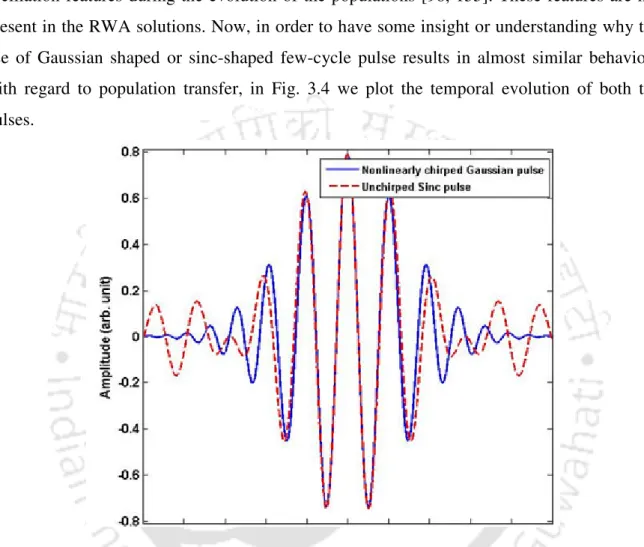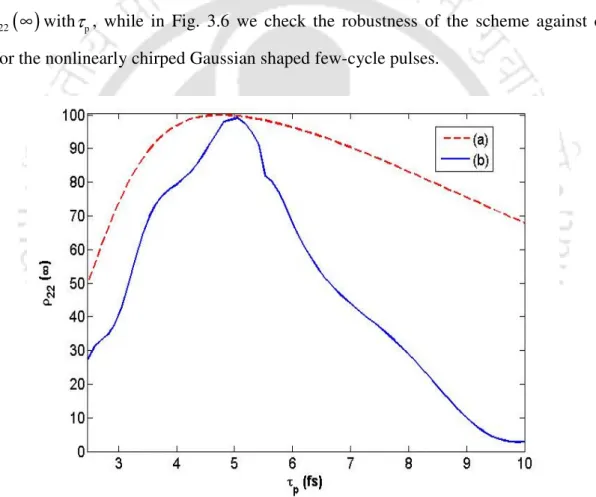It is confirmed that the work contained in the thesis entitled "Coherent control and manipulation of atoms using femtosecond pulses" by Mr. On the other hand, since the seventies of the last century, laser-induced forces, the so-called optical dipole force and the dissipative force, have have been used routinely for the manipulation of atoms.
Contents
31 3.12 Final population transfer to quantum state 2 as a function of the dipole moment coefficient β and the highest Rabi frequency Ω. 40 4.5 Contour curves of the finite population ρ ∞44( ) for changing the frequency shift parameter, α and the frequency shift-stare parameter, τ.
Introduction
Background
With the counterintuitive sequence of the pulses, therefore, complete population transfer to the target state could be achieved. At the beginning of the interaction (the leading edge of the laser pulse) the frequency of the laser pulse is far from resonance, while in the middle of the laser pulse it is swept through resonance with the atomic transition and then goes out of resonance at the end of the interaction (the trailing edge of the laser pulse).
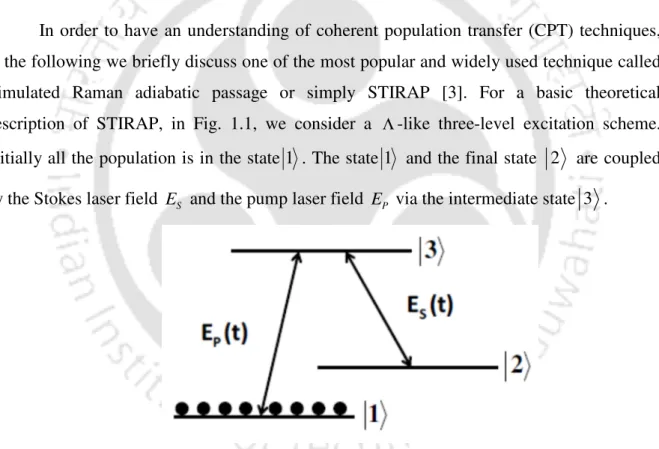
The relevance and the aim of the topic of research
Gaussian-shaped pulse envelope, ω is the center frequency and Ε0 is the peak amplitude of the pulse envelope. The CEP can be defined as the phase delay between the highest half-cycle of the electric field under the pulse envelope and the peak of the envelope itself [82].
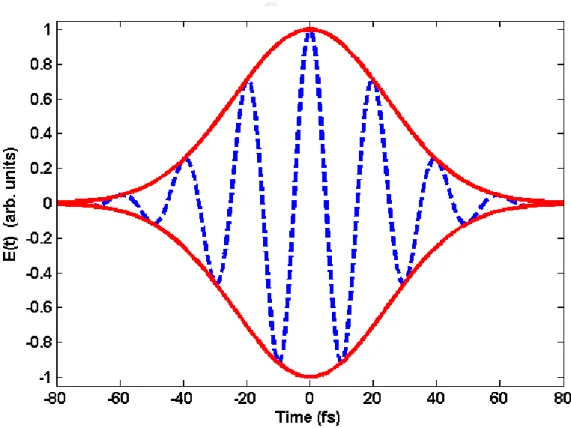
Organization of the Thesis
Thus, one of the goals of the present thesis is to study the effect of femtosecond pulse-induced optical power on the motion of two- and three-level atoms. It should be noted that the magnitude of the dissipative power induced by commonly used CW lasers is limited due to spontaneous decay process.
Ultrafast Coherent Population Oscillations in Two-Level Atomic Systems*
Introduction
137] reported that the so-called area theorem becomes invalid for the attose customer pulse propagation in dense two-level medium. In another study of femtosecond pulse propagation in dense two-level medium, Kalosha et al.
UCPOs in dense two-level atomic systems
2.2 (a) that all atoms during the interaction with the initial pulse (n=0) in the pulse train are transferred to the up-state, with the highest Rabi frequency at t=0. The dwell time of the atoms in the raised state is almost the same as the pulse repetition time (tr), chosen to be 500 fs in Fig.
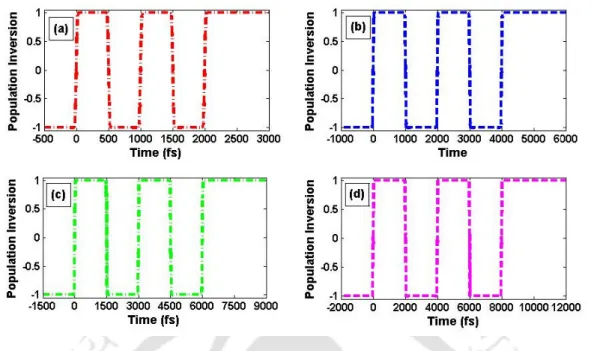
UCPOs in dilute two-level atomic systems
2.3 (b) and that the UCPO characteristics, τa ≈tr and fucpo ≈1 2tr, do not remain if the highest Rabi frequency is not equal to the NDD parameter. In the next section, we report our studies on UCPOs induced by a train of linearly chirped femtosecond pulses in a dilute two-level medium. It should be noted that a laser pulse with parameters similar to those chosen here can be generated experimentally [141, 142].
Ultrafast coherent population oscillations in two-level atomic systems. w>0) to absorb (w<0) as a function of the number of pulses in the pulse train. The atomic medium, for odd number of pulses in the pulse train, can be interpreted as an 'on'. Therefore, the present scheme can serve as a unique ultrafast optical switch, where the switching time can be controlled as follows: when a switching signal enters the absorbing medium (w<0), the interaction can take place between the switching signal and the absorbent. medium; thereby, the coupling signal may be absorbed in the medium due to the absorbing nature of the medium.
On the other hand, when the switching signal enters the gain medium (w>0), there may be an interaction between the switch signal and the gain medium; as a result, the switching signal may not be absorbed in the medium due to the amplifying nature of the medium. The remarkable properties, namely τa ≈tr and fucpo ≈1/2tr, of UCPO remain invariant for pulse envelopes of different shapes, such as: Sech, Sinc and Lorentz shaped pulse envelope. Since the final population inversion and UCPO are sufficiently robust against the variation of the laser pulse parameters, the proposed scheme can enable the efficient creation of a complete population inversion in the ensemble atoms located at different spatial points covered by the laser pulse.
2. 4 Chapter Summary
- Introduction
- Few-cycle-femtosecond pulse driven coherent population transfer
- Single few-cycle-femtosecond pulse driven coherent population transfer
- Chapter Summary
The non-adiabatic consequences on the temporal evolution of the populations can be observed from Fig. It is important to verify the stability of the scheme against the variation of the chirp rate and the temporal pulse width of the Gaussian-shaped few-cycle pulse. 3.5(a) that the final population transfer ρ22( )∞ to quantum state 2 is sufficiently robust against the variation (4–6 fs) of the time width of a Gaussian.
3.5(b) shows that the final transfer of the population ρ22( )∞ to quantum state 2 is robust against small variations fs) of the time width of the sinc pulse. 3.7, the final population transmission ρ22( )∞ is very robust with respect to the variation of the carrier envelope phases φ1 and φ2 of a few cyclic pulses in the form of sinc. 3.8 we show the contour map of the finite population up to quantum state 2, i.e. ρ22()∞, versus the Rabi frequencies Ω31 and Ω32 of a nonlinearly chirped Gaussian pulse with a few cycles.
The robustness of the population transfer with sink-shaped few-cycle pulses is depicted in Fig. The non-adiabatic consequences on the temporal evolution of the populations could be observed from fig. Next, we investigate the robustness of the final population transfer to quantum state 2 as a function of the pulse duration and the Rabi peak frequency.
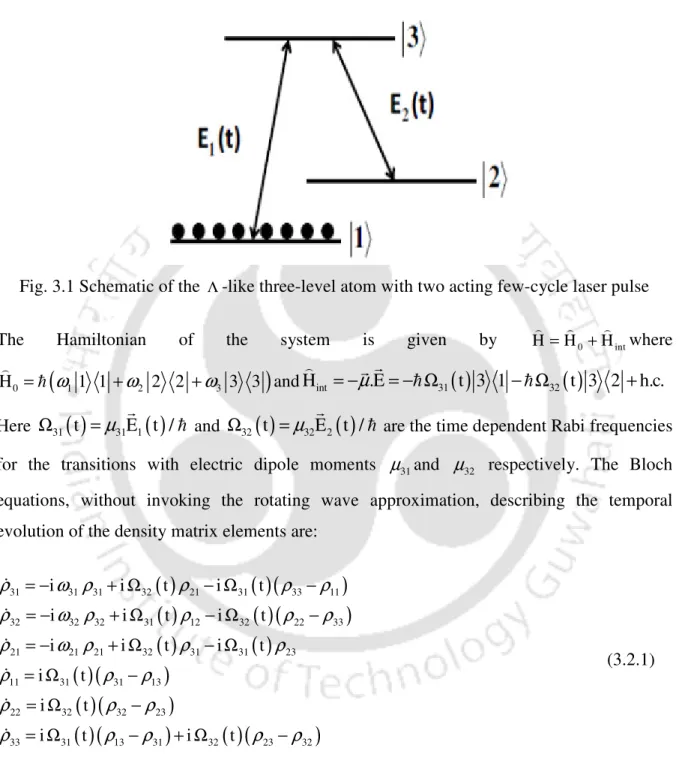
Coherent Population Transfer in Multi- level Atomic Systems*
- Introduction
- Selective coherent population transfer in Y-like four-level atoms
- Chapter Summary
- Chapter 5
The chirped shape of the pulse can be controlled by manipulating the three parameters α, t0 and τ. Figure 4.2 shows the effects of varying the control parameters on the time-varying pulse frequency. Figure 4.2(d) shows that for the frequency-steepness parameter τ= 8 fs, together with the sweeping, a steepening temporal profile of the pulse frequency also occurs.
4.3 we show the temporal evolution of the pulse frequency, pulse envelope and populations in different states. 4.5 we present the result of the simulation for the variation of the final transfer of the population to state 3, i.e. ρ ∞33( ) and state 4, i.e. ρ ∞44( ) with frequency sweep and frequency sweep parameters. Thus, the final population transfer to country 4 is stronger compared to the final population transfer to country 3.
To explore the reason behind this difference more clearly, we plot the temporal evolution of the time-varying pulse frequency in Figure 4.7. We show the robustness of the final population transfer to state 3 with respect to pulse width and time-independent Rabi frequency. The selective population transfer is found to be robust against variations of the simulation parameters such as the time-independent Rabi frequency, frequency sweep parameter, frequency steepness parameter and dipole moment coefficients.

Optical forces on two-level atoms*
- Introduction
- Theoretical Model
- Numerical results and Discussions
- Chapter Summary
Here, Ω is the transition frequency of two-level atoms and ΩR( , )r t is the Rabi frequency, which is defined as. In the rest, the Rabi frequency used refers to the highest Rabi frequency. The r-component of the light force is called the transverse force, FT, while the z-component is called the longitudinal force, FL.
5.2 (a) shows that, since the transverse force is negative, atoms with two levels in the atomic radius experience a net attractive force that can result in focusing of surrounding atoms. A train of pulses with few cycles can be used to increase the effective focusing of the atoms. The fact that the transverse component of the light force vanishes within the RWA under the resonant condition is supported by analytical calculations reported in Ref.
5.6(a) shows that the longitudinal component of the light force is non-zero when Ω < ΩR , a regime where RWA can be valid. A rigorous numerical study has been performed to analyze the focusing, defocusing and steering of neutral atoms in the laser field. The so-called optical potential can be used for stable trapping of two-level neutral atoms for large positively detuned interaction.
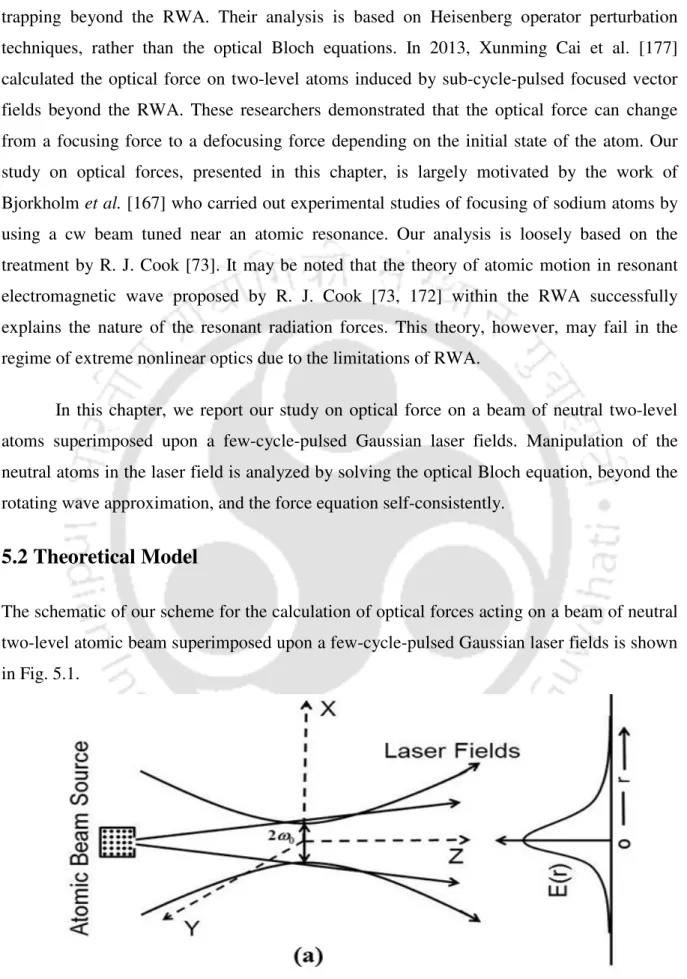
Optical Dipole Force on Three-level Atoms*
- Introduction
- The Model
- Numerical Results and Discussions
- Chapter Summary
In this chapter, we report a study of the optical dipole force on three-level atoms under three different excitation schemes. 6.1 (a) Sketch of the proposed scheme for calculating optical dipole force on an atomic beam propagating along pulsed laser fields. 6.2(a) and 6.2(b) that the optical dipole force is negative for positive tuning, which can lead to focusing of atoms, while Figs.
6.2(c) and 6.2(d) show that the optical dipole force is positive for negative detuning, and can lead to defocusing of atoms. Again, the temporal evolution of the optical dipole force remains similar even as the number of pulses is increased. The optical dipole force is negative for positive detuning and positive for negative detuning throughout the interaction time.
So it appears that the optical dipole force is acting as an ultrafast optical lens for the divergent atomic beam. Therefore, the dipole optical force can be used to focus and defocus atoms with reasonable control of the sign of the chirp parameters. This chapter discusses the optical dipole force on a scale such as the three-level atomic system driven by pulsed laser field trains.
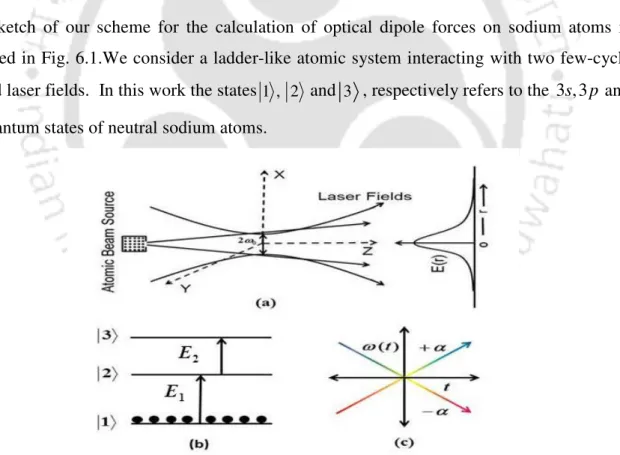
Conclusions and Future Aspects
- Conclusions
- Future Aspects
- Thesis Publications: Peer Reviewed Journals
- Thesis Publications: Conferences(International/National)
- Related Publications: Conferences(International/National)
Sarma, "Frequency-modulated optical pulse train with few cycles induced controllable ultrafast coherent population oscillations in two-level atomic systems," Physical Review A. Sarma, "Optical dipole force on ladder-like three-level atomic systems induced by a few-cycle - pulsed laser fields," Physical Review A. Sarma, "Gaussian and sinusoidal pair-cycle pulse-driven ultrafast coherent population transfer in - like atomic systems."
Sarma, "Optical force on biplane atoms by pair-cycle-pulse Gaussian laser fields beyond the rotating wave approximation." Sarma, "Ultrafast and selective coherent population transfer in tetrahedral atoms by a single frequency chirped pair-cycle pulse." Sarma, “A numerical study of optical dipole force on three-level atoms by chirped pair-cycle-pulse laser fields”, Frontiers in Optics/Laser Science XXVIII meeting, Rochester, USA, Oct.
Sarma, "Coherent population transfer in - like three state atomic systems with min-cycle femtosecond pulses", National Conference on Advances in Physics, Department of Physics, IIT Roorkee, India, February Sarma, "Time-dependent optical power on two-level atoms by min-cycle pulsed Gaussian laser field beyond the rotating wave approximation", 3rd International Conference on Current Developments in Atomic, Molecular, Optical and Nanophysics, New Delhi, December Sarma and Parvendra Kumar, "Modulation instability of few-cycle pulses in quadratic nonlinear media", 3rd International Conference on Current Developments in Atomic, Molecular, Optical and Nanophysics, New Delhi, Dec.
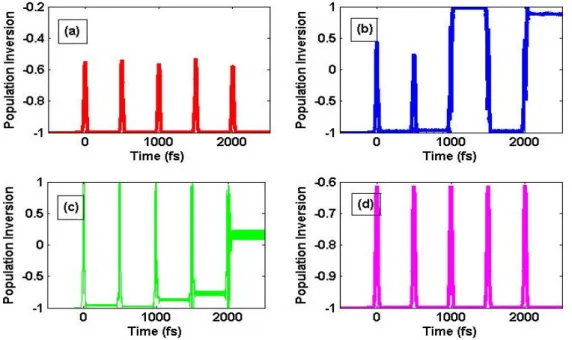

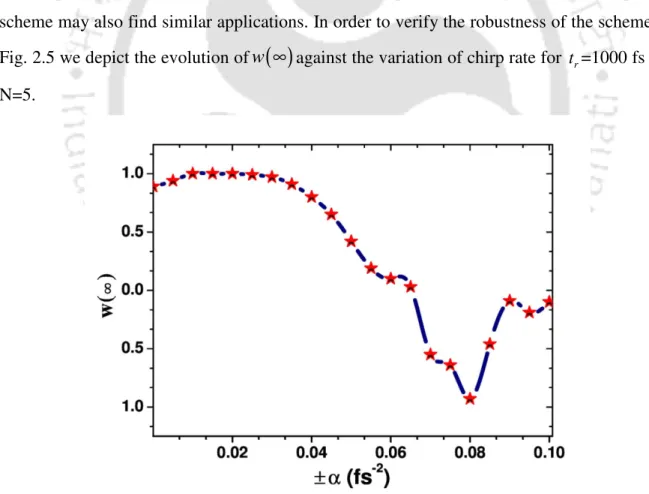
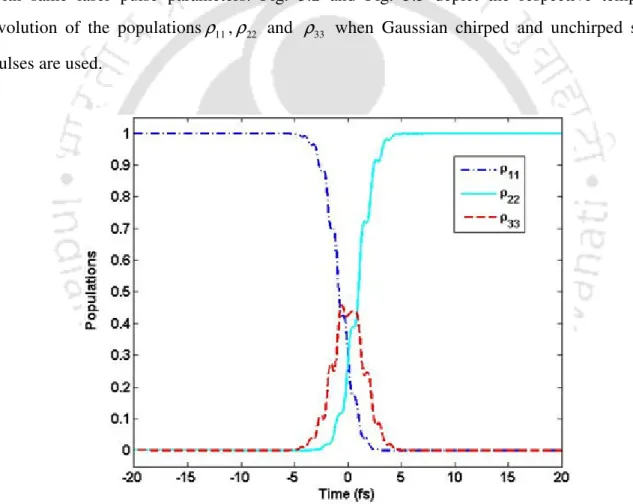
![Fig. 3.3 Temporal dynamics of populations with the Sinc-shaped few-cycle pulse These results could be explained on the basis of the so-called Stimulated Emission Pumping (SEP) [31]](https://thumb-ap.123doks.com/thumbv2/azpdfnet/10493044.0/43.892.147.746.203.690/temporal-dynamics-populations-results-explained-stimulated-emission-pumping.webp)
